The opening chapter:
Let me share a narrative that illustrates the future of teacher professional development. This is not a speculative tale set in a distant future; rather, it's the opening chapter of a story unfolding right now.
While you may consider Lena's story fanciful, we assure you that everything described is achievable within the next few years. To illustrate, please review this video created by our Research and Development team.
As you can see, our system can already analyse videos of classroom teaching, providing both quantitative and qualitative outputs. The system can even include Professional Development recommendations based on the video analysis. These tools are customizable by the teacher or PD leader and can be used over multiple videos to gain deep insight into teaching and learning across an organisation. Thus far our testing indicates the results are accurate, or at least within the same level of variation one would expect from trained human observers.
This technology holds enormous power and has profound implications for the education system. We reflect on some of the broader themes here.
One thing is certain: we all need to think carefully about how to leverage this technology effectively. The exciting part is that we have the opportunity to co-author the subsequent chapters through the IRIS Connect AI Early Access Project.
What follows is Lena's story, a vision of what an AI-powered cycle of professional development could look like in the near future.
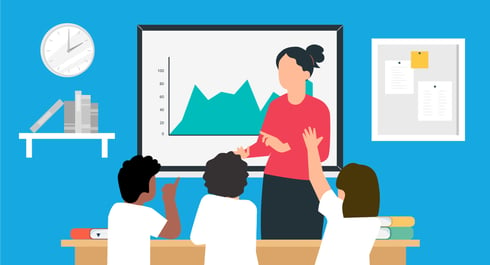
Lena's Story

Lena is a second-year Early Career Teacher (ECT) who has just completed her third lesson of the day. She is busy, stressed and time poor. She also loves what she does and is proud of her progress.
Insight Dashboard
During her lunch break, she opens her professional development app and clicks on a feature labelled "Insights." The dashboard displays key metrics related to skills she has been working on, such as pacing, clarity, wait-time, and fostering richer dialogue in lessons. All metrics are in green, which pleases Lena; these skills have become second nature to her, allowing her to focus more on her students' individual needs.
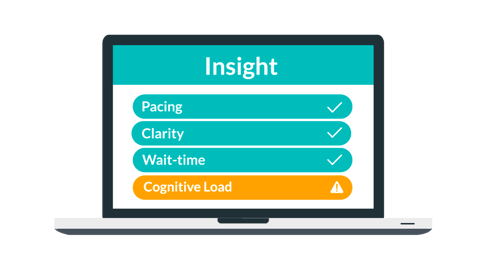
Cognitive Load Alert: An Area for Attention

However, Lena notices an alert marked in orange that reads "Cognitive Load." Intrigued, she expands this section of the dashboard. She finds links to specific moments in her recent lessons where the AI has estimated that students were likely experiencing cognitive overload. This estimation is based on factors like what the students had previously learned, the intrinsic load of the material and an analysis of speech patterns.
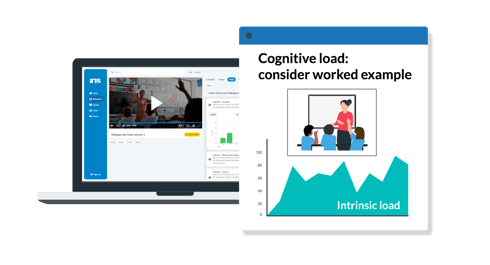 Delving Deeper: Video Insights and AI Feedback
Delving Deeper: Video Insights and AI Feedback
Lena clicks on these links to watch video clips of these key moments. After viewing, she provides feedback to the AI assistant, agreeing that her students were struggling and expressing interest in exploring this further.
The AI assistant then provides Lena with written feedback, focusing on the likely cause of the additional cognitive load. It suggests that the absence of a worked example (or example-problem pair) before independent practice might be the issue. Lena is also given a one-minute explainer animation and a short reading task related to the "I do, we do, you do" teaching strategy, which she considers on her way home.
 The Next Day: A Prompt for Professional Development
The Next Day: A Prompt for Professional Development
The following day, Lena receives a prompt asking if she would like to start a short, accredited professional development pathway focused specifically on scaffolding independent practice. She accepts and informs the system when she plans to commence.
Lena is then presented with options for the type of learning pathway she wishes to pursue. She may choose to work independently with AI support, collaborate with an instructional coach, or join a group of five other teachers with the same focus, supported by AI. Based on Lena's needs and previous professional development experiences, the AI assistant recommends the third option, which Lena selects.
 Tailored Learning Resources: Cognitive Load Theory and More
Tailored Learning Resources: Cognitive Load Theory and More
Lena is guided to a comprehensive learning resource on cognitive load theory. The AI assistant has highlighted specific areas for key reading based on an assessment of her needs. Lena opts to enable the "knowledge feed," which means she will receive theoretical vignettes and animated dual-coded overviews at regular intervals over the next month. These are timed to coincide with when she is most likely to engage with them, such as during her morning commute.
Collective Reflection
Next, Lena is invited to join a Teacher Learning Community (TLC) focused on developing scaffolding strategies. During their meeting, they discuss the theory and watch a video of practice together. The session is facilitated by the PD lead, who has also received support from the AI assistant beforehand. A number of key discussion points have been suggested by the AI assistant to enhance the deconstruction process. At first the questions encourage the teachers to consider what is happening in the lesson clip, then stimulus questions support the connection of practice to theory. Finally, they discuss questions related to implementation in their unique contexts.
Hands-On Practice: AI-Powered Scenarios and Real-Time Feedback
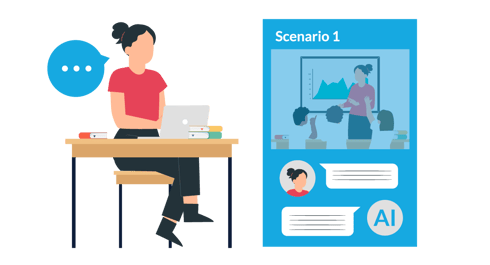
Lena next engages with AI-powered scenarios that provide information about the students' prior learning, additional needs, and curriculum objectives. She is tasked with identifying the appropriate degree and nature of scaffolding to support independent practice. As she interacts with each scenario, she receives immediate feedback and suggestions for refinement.

In her next free period, Lena decides to deliberately practise the skills associated with providing a worked example. She is presented with an animated overview of the procedure, which pauses after each key skill is explained. Lena then replicates the skill in front of a webcam, and the animation continues. At the end of this process, she records herself implementing the full sequence of skills and receives developmental feedback from both the AI assistant and a peer.
 Supporting the Transition
Supporting the Transition
As Lena plans her next lesson, the AI assistant provides suggestions for optimising her lesson plan and generates all the necessary lesson resources. When Lena walks into her next class, she enables an app on her mobile device. This app provides real-time prompts during the lesson, helping her stay aligned with her chosen teaching strategy. These prompts are timed to ensure they don't distract her but rather support the implementation of the next step.
 Reflective Practice: Review and Adaptation
Reflective Practice: Review and Adaptation

After the lesson, Lena reviews the video recording, especially focusing on the “notable moments” which have been automatically created on the video timeline. As she reflects she records what she would like to do differently next time. She also shares her video with a peer for feedback and, in turn, reviews their video.
Over time, she records more lessons and requests feedback from the AI assistant. The AI assistant's feedback evolves over time, initially focusing on skill implementation but soon shifting to support the development of Lena's mental model and reflective skills. This helps her fine-tune her new approach and meaningfully connect it with her other teaching strategies.
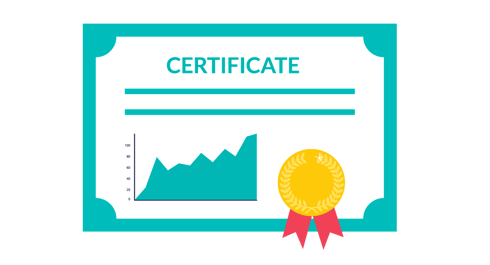
Certification and Portfolio: Documenting Professional Growth

Next, Lena rejoins her Teacher Learning Community to discuss what she has learned, the challenges she faced, and suggested refinements to the process.
Finally, Lena receives a certificate of completion, which includes a quantitative estimate of the impact her new skill has had on student progress. This is based on automated analysis of videos and other learning artefacts from before and after the PD pathway.
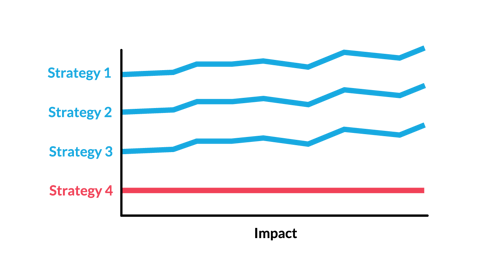 This analysis not only provides affirmation for Lena but is also combined with the results of all the learning pathways across the organisation to ensure the strategies being advocated are actually having the desired impact on learning.
This analysis not only provides affirmation for Lena but is also combined with the results of all the learning pathways across the organisation to ensure the strategies being advocated are actually having the desired impact on learning.
Lena's certificate is automatically added to her portfolio, which can be effortlessly and securely shared with accrediting bodies, school leadership, and other teachers within her learning community.
Now that the skill is secure, it is added to the dashboard, and key metrics help Lena identify if she needs to revisit any element of the strategy. She can now choose her next professional development focus or wait for a recommendation from her insights dashboard.
Empowering Leadership: The Synergy of Human Expertise and AI Capabilities
One of the most exciting aspects of this transformative journey is the role that professional development leaders and instructional coaches play in shaping and guiding the process. While the AI-powered platform offers unprecedented scalability and personalization, it is not designed to replace the invaluable expertise and insights that leaders bring.
Adaptive Frameworks
The professional development platform feeds key information and carefully crafted prompt sequences to large language models (and other AI systems) for analysis and feedback. This feedback is presented to Lena and archived for use in future prompts, enabling the AI to support dynamic processes over time.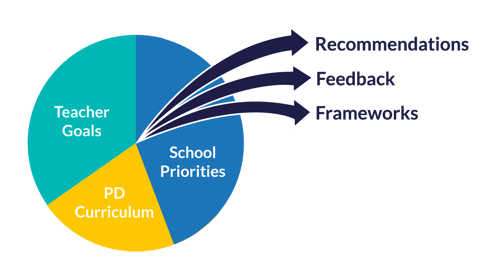 The framework is flexible and adaptive at the curriculum, school, and user levels. Lena can tell the AI what she wants to focus on and provide key information about her local context. School leaders also add their needs to this "prompt blend" to reflect school priorities and current initiatives. At a curriculum level, the system knows that Lena is an Early Career Teacher and has a defined set of learning objectives. Her feedback and recommendations are informed by this architecture.
The framework is flexible and adaptive at the curriculum, school, and user levels. Lena can tell the AI what she wants to focus on and provide key information about her local context. School leaders also add their needs to this "prompt blend" to reflect school priorities and current initiatives. At a curriculum level, the system knows that Lena is an Early Career Teacher and has a defined set of learning objectives. Her feedback and recommendations are informed by this architecture.
The platform facilitates a collaborative feedback loop between teachers, AI, and professional development leaders. Leaders can review the AI-generated feedback and recommendations, adding their own insights and suggestions. They can also assess whether their advocated strategies are having the desired impact and adapt programs of learning based on this evidence.
This creates a rich, multi-dimensional professional development experience that benefits from both human expertise and AI capabilities.
A Partnership for the Future
So, that was Lena's story. Did it fill you with excitement, concern, or something in between? Our intention is to present you not only with what can be but also with what we believe this technology must be: a partnership with humans at its core. A use of artificial intelligence which facilitated not only more scalable and effective professional learning but also learning that was more personalised, sensitive, and developmental.
The first iteration of AI tools are now live on IRIS Connect
We are excited to say that we have launched the first iteration of AI tools for instructional coaching and reflection.
- Teachers get actionable lesson feedback within seconds
- Coaches focus their valuable time on in-depth, targeted support
- Leaders provide personalised PD despite capacity limits
Find out more about our AI tools here as well as exclusive offers.

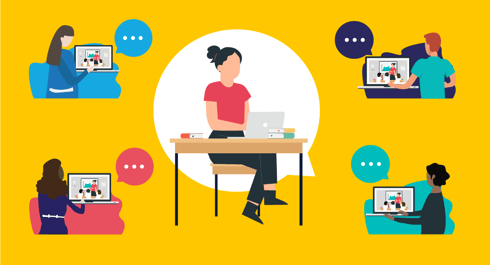

Leave a comment:
Get blog notifications
Keep up to date with our latest professional learning blogs.